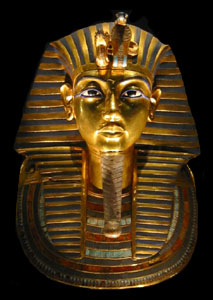
Unfortunately, Howard Carter and his team were not particularly careful with the body of the Tutankhamun when they investigated his tomb. They were more interested in removing the jewellery and amulets that were placed within the mummy wrappings than in preserving his body for posterity. In their haste they caused a huge amount of damage. Many items were stuck to the wrappings with solidified resin and hot knives were used to pry them free and to remove his golden funerary mask. His body was also cut into pieces with his arms and legs detached, his torso cut in half and his skull damaged.
Since then, Tutankhamun’s mummy has been X-rayed three times (in 1968, 1978, and in 2005) but these scans have been unable to confirm beyond a reasonable doubt, the cause of his death. The first scan found a dense spot at the back of his skull which was interpreted as evidence of a subdural hematoma. This injury certainly could have cause his death, but although at least one specialist has suggested that it is unlikely that a fall could cause an injury at that location, there is no clear evidence that this injury was intentional. Calcification at the site of the injury suggests that he did not die immediately, but again cannot confirm the ultimate cause of his death.
The latest scan found no trace of the dark spot and proposed that the body was only damaged post mortem. The medical experts concluded that there was no evidence that he had died as a result of a blow to the head. They did find two loose bone fragments in Tutankhamun’s skull, but it is considered extremely likely that these were the result of post mortem damage caused either during the mummification process or by Carter’s team on excavation.
The medical team did report an injury to Tutankhamun’s thigh. This injury would not have been life threatening, but it is possible that he succumbed to an infection as a result of this injury which cost him his life.
There was also no evidence of any genetic abnormality (of the kind sometimes attributed to Akhenaten), but there was evidence that he suffered more than one serious bout of malaria and may have had a cleft palate.
In 2010, it was proposed Tutankhamun died of sickle cell disease – this hypothesis has not gained much ground. In 2013, Chris Naunton suggested he died of injuries sustained in a chariot accident, but a further investigation the following year reported the injuries which led to this conclusion were post mortem. This latest investigation also concluded he had a clubbed foot which would have prevented him from standing upright without support, making it highly unlikely he was engaging in chariot races.
The exact cause of Tutankhamun’s death remains a mystery.
If Tutankhamun was murdered, there is one prime suspect – Tutankhamun’s vizier, Ay. Ay became pharaoh on the death of Tutankhamun and therefore undoubtedly profited from his demise. There is evidence that that Ay married Tutankhamun’s wife Ankhesenamun (Ankhesenpaaten) and a letter thought to have been written to Suppiluliuma by Ankhesenamun implies that this marriage was against her will.
In the letter, the queen begs the Hittite king for one of his sons to marry because she does not wish to marry a subject (probably Ay). Furthermore, the correspondence indicates that Ay may also have killed (or at least ordered the death of) the son of Suppiluliuma sent in response to the request.
It is also possible that Horemheb, the successor of Ay and Tutankhamun’s general, was involved in the murder of the Hittite prince and that a deal was struck whereby he would ascend to the throne after Ay. Without more concrete evidence, this is all conjecture but there is certainly grounds for suspicion.
Another theory suggests that Tutankhamun was the pharaoh of the Exodus and that he sustained an injury to his head and thigh (which caused his death) while pursuing the Israelites as they fled Egypt. The source of this story is the Talmud, but the pharaoh is never named and so the connection remains highly speculative.
- Tomb of Tutankhamun
- Tutankhamun
- Tutankhamun cache (KV 54)
- “Curse” of Tutankhamun’s tomb
- Ankhesenpaaten (Ankhesenamun)
- Amarna Royal Family
- Amarna Religion
- Amarna Letters
Copyright J Hill 2016